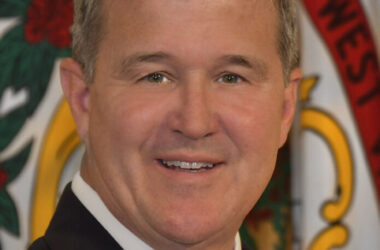By Don Smith
Executive Director of the West Virginia Press Association
and
Moundsville, W.Va., native
If you haven’t already, take time to read Ken Ward’s article: ‘Reasonably necessary’? How natural gas drilling is changing WV’s landscape:
It’s excellent work.
I thought about Ken’s article and the issues he outlined as I returned home to Marshall County during the weekend before Christmas to visit my family. My Mom lives on a 25-acre farm near Limestone, W.Va., in the natural gas region. It’s an hour north of the Wetzel County community Ken visited.

Executive Director
West Virginia Press Association
My four siblings and I grew up in rural Marshall County on a beef cattle farm. Kids growing up in that region played baseball and swam each summer in Moundsville or Cameron. Many graduated high school and went on work in one of the chemical plants, power plants or coal mines in the region. Some went to college, with most of them moving away for work.
Personally, I worked in two power plants, a coal mine and later, after a layoff, went to college and moved from Moundsville. My first stop wasn’t far: New Martinsville in Wetzel County, where I served as editor of the Wetzel Chronicle for several years.
During my Christmas visit, while lying in bed, I heard the “ja,ja,ja,ja,ja” of air brakes throughout the night as the numerous trucks slowed at the intersection of WV 88 and US 250, just a few hundred yards from the house.
And before dark that evening, my Mother, looking toward the field across the hollow near her farm, had asked, “What’s the brown area near that gas pad they are building? Is it just how the hillside is cut away?”
At 80, her vision’s not sharp. Still, it appeared she’s right about the hillside. There is a gas pad development just a few hundred yards from her backdoor and the hillside has been scraped to make room.
Each day Mom is experiencing the impact of the natural gas industry.
Traffic, potholes and natural gas developments are everywhere, Mom said, adding “You can’t get through Moundsville during the day for the traffic.’
Age and vision issues aside, Mom’s observations seemed pretty accurate based on my experiences during our holiday stay.
Her comments, however, weren’t complaints, just facts of life.
For her, and many in Marshall County, life has changed for the better since the natural gas boom.
Landowners with mineral rights in Marshall County — many of whom are senior citizens like my Mom — are seeing the benefits of lease payments and, as the pipelines are extended, expect to collect royalty payments.
For me, it’s comforting to know my parent is as worried about paying the taxes on her lease income as she is about meeting her monthly bills with just social security and pension income.
For many residents, the natural gas industry has meant money in the bank, a newer vehicle in the driveway and improvements to their property. Most have already banked a second round of lease payments.
In the Ohio Valley, gossip during retirees’ morning coffee chats or weekly lunch gatherings often focus on neighbors’ royalty payments as much as health problems or the passing of another friend.
And the natural gas developments aren’t just impacting the mineral owners.
After months of working six days a week on gas pipeline construction, many local residents — including several in my family — have started winter layoffs, but there was money for Christmas, bills caught up, savings in the bank, and work expected in the early spring.
The last three years of work on the pipelines have really helped many Ohio Valley residents with their finances. Stocking shelves at retail stores and working in fast food restaurants and service industries kept food on the table, but life was a struggle for families.
Today, the talk in Moundsville is about work, not unemployment. You often hear this statement: “There are jobs now, if you’re not on dope.” In Marshall County, as with much of West Virginia, drug problems still keep many unemployed or under-employed.
But it’s not easy work. The jobs involve manual labor, heavy equipment, transportation, land reclamation and all the related jobs and industries around gas drilling and pipeline construction. Workdays can be 10 to 12 hours and workweeks are six or even seven days, but workers say the pay is worth the effort.
Available rental property seems much less common than jobs as pipeline workers from other areas spend per diem on housing and camper lot rentals. Motels, restaurants, gas stations and other service industries are also benefitting from the presence of the pipeline workforce.
At least one hotel owner had planned to renovate or rebuild his facility, but those plans are on hold: Why rebuild when the hotel is filled in its current condition. Muddy boots in the hallways and muddy trucks in the parking lot are acceptable if the hotel rooms are full.
There is economic activity in the region.
The Ohio Valley’s job market and economy has suffered since the late 1970s when steel mills, coal mines, glass plants, chemical plants and other industrial operations began closing operations and reducing work forces. It’s been decades since Northern Panhandle workers could “quit a job today and get another one tomorrow.”
More recently, the Ohio Valley experienced decades when good-paying jobs were hard to find.
Over the years, vibrant downtowns faded, turning to empty lots and vacant storefronts. Properties once well maintained became run-down, clearly needing investment.
The natural gas boom has provided new revenue and opportunity.
It hasn’t been easy, without problems or supported by all, as Ken’s article clearly documents.
There are serious questions to address: Environmental questions, property rights issues, taxes, safety problems, industry developments issues, and legislative proposals are of concern to all West Virginians. We need to find answers.
Certainly the traffic, mud and noise are real problems. However, for my family and so many others in the region, those are acceptable short-term inconveniences if the State of West Virginia and the gas industry can develop a program that means jobs, income, a responsible operation and hope for a better future for the region’s residents.
How long will these pipeline jobs last? Not long enough. Residents understand the pipeline construction jobs are short-term. They know the state must capitalize on the presence of natural gas to continue development in their region.
Visits to Moundsville now routinely include a ride across the bridge to Dilly’s Bottom, Ohio, to look at the possible cracker location.
Local officials will learn to manage the growth if a cracker becomes a reality and other “down stream” operations fill the Ohio River bottoms between Moundsville and New Martinsville.
That region was once home to much of the Northern Panhandle’s chemical, power plant and coal facilities and served as the economic engine for the region. In those days, too, traffic was bumper to bumper at shift change and Moundsville was a busy, growing industrial community with all the related problems we are seeing today.
During the last 40 years, local officials learned all about the struggles of managing the region without enough jobs or industry.
For now, everyone has hope. Yes, it’s loud, dirty, inconvenient and without a guarantee, but it’s hope. For many Northern Panhandle residents, having hope is a positive change.




